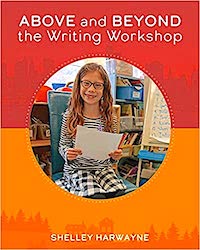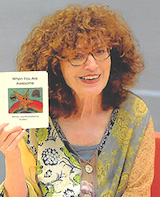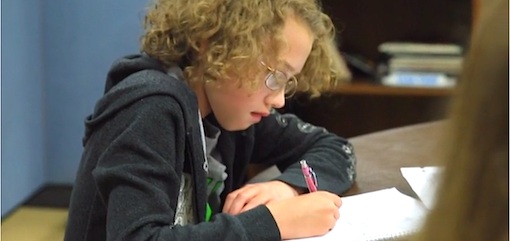Enticing Students with New Writing Challenges
I loved being a principal. I loved visitors’ reactions to some of the untraditional tasks I relished in that role. These included decorating bulletin boards, creating a poetry reading room, and hosting parent writing workshops. Perhaps the unorthodox role that taught me the most was a tutorial I ran for struggling readers. Teachers recommended students who needed additional support. In retrospect, I learned more than I taught in these lunchtime tutorials.
I learned that teachers apply the term “struggling reader” to a wide range of students. I learned about the range of reading material available in our school. I learned about the frustration of interruptions. I learned about individual students’ strengths, weaknesses, interests, and attitudes.
Most of all, I learned whether I had what it takes to really teach students how to read. Not surprisingly, I highly recommend that all administrators take on teaching tasks – that they find ways to do some of what classroom teachers are asked to do. They too will learn more than they teach.
We want them to see us writing
It is with that same belief in my heart today, over thirty years since becoming a principal, that I highly recommend teachers do what they ask their students to do, especially in the teaching of writing. I still value the words of the late and brilliant Don Graves who asked, “If it is not for us, why should it be for them?”
Here, I am not talking about writing a short paragraph or two to demonstrate a writing technique. I’m not simply suggesting teachers write to create mini-lessons, as powerful as those might be. Instead, I am talking about teachers writing with gusto, devotion, and delight as they complete the writing tasks they ask of their students.
Such commitment begins with the choice of the genres and formats that are assigned to students. Teachers need to ask themselves, “Would I want to write a persuasive essay, a personal narrative, a feature article?” If the answer is “Not really,” then teachers need to introduce or invent genres that prove irresistible to young and old alike.
That’s exactly what I set out to do when I teach. Although the writing challenges I design aim to be rigorous, I try to make sure that there is an element of joy attached to these assignments. (That’s another big lesson I learned from heading up a school. Classrooms can be simultaneously joyful and rigorous). When assignments are enticing and engaging, it becomes rather easy for students to do what they’re asked.
Instead of that, I do this…
►Instead of asking students to write the traditional school report about a foreign country, I ask students to pick a topic they really care about and find out how that event, tradition, occupation, etc., plays out in several different countries. (How do people around the globe celebrate their birthdays? How is garbage collected in different countries? What are favorite desserts in different parts of the world?)
►Instead of asking students to write traditional biographies of famous people, I ask students to connect several famous people by an organizing trait. (Who are some famous left-handed people? Which famous people are known for their iconic eyeglasses? Who are some folks that have their faces on postage stamps?)
►Instead of the usual research report, I ask students to create a non-fiction calendar, choosing a broad theme and writing 12 paragraphs exploring that theme, one for each month with illustrations alongside. (Imagine a calendar devoted to sports, with a dozen sub-topics. Or a calendar devoted to musical instruments, favorite authors, or women inventors?)
►Instead of the traditional persuasive essay, I ask students to take part in a “Would you rather…?” writing challenge, asking thoughtful questions, and then providing readers with enough solid information to make informed decisions. (Would you rather be an archeologist or a paleontologist? Would you rather live in Sweden or Switzerland? Would you rather see a hedgehog or a woodchuck in your backyard?)
Creating new and unusual challenges
Of course, not all the writing challenges I design can be described as replacements for more traditional ones. Often, I am inspired to create more unusual units of study based on my own adult reading.
For example, I read a newspaper column in which the journalist created a series of surprising awards for some spectacular birds. I was inspired to do likewise: choosing my own area of interest, I created a list of awards as well as paragraphs to explain each choice.
My topic was children’s literature. My awards included the “Most dog-eared book award,” the “Most often quoted at graduations award,” and the “Most revered book from childhood award.” Next, I wondered if students would be interested in creating their own awards and most importantly what they would learn from so doing.
Such alternatives to the usual school assignments often appeal to students as well as to their teachers. The writers understand that they are creating something fresh, original and a bit surprising. And administrators come to understand that there are many ways to meet curriculum goals.
Why I like short pieces of writing
Teachers note that the writing challenges I suggest often result in short pieces of writing. That is by design. There is much to be said for short genres. And writing short pieces is not necessarily easier. (I’ve been watching my teenage grandchildren grapple with limited-word college application essays.)
Writers of poetry, short stories, picture books or op-ed pieces will confirm that short does not mean easy. They are not easier, but they do offer several instructional benefits.
- Shorter texts tap into students’ tastes as readers, their willingness to revise and their interest in experimenting with many different genres and formats.
- Shorter texts make it easier for teachers to read and respond in a timely fashion.
- Shorter texts facilitate making copies for more people to read drafts.
- Shorter texts appeal to busy teachers who write alongside their students.
- Above all, shorter texts enable writers to have a go, again and again.
During the pandemic lockdown, I learned to make paella. I made it several times during those many months at home, and each time it got better and better. I took notes, made recipe revisions, and tried again. The same can be said for teaching short genres. Students would have time to try it again. In fact, most of my favorite writing assignments invite students to produce several finished products.
Writing challenges for older students
I’ve yearned for pandemic restrictions to be over so I can return to classrooms once again. There are several writing challenges that I long to try out with older students. If we were to create a room for using building blocks in our schoolhouses, we would expect sixth graders to create more sophisticated constructions than second graders. (That room was a dream of mine as a principal!)

Seventh graders need to be presented with more sophisticated information about Martin Luther King Jr’s accomplishments than that offered to second graders. Fifth-grade poetry courses of study should contain more complex poetic forms than those presented to first graders.
When I ask elementary students to create author scrapbooks about their favorite authors, they are asked to include a biographical sketch of the author, several reader responses to the author’s books, and comments on the author’s crafting techniques. If I were to engage middle school students in this challenge, I might ask them to also explore how that author’s life story impacts his or her work. It’s an extra layer that I too would enjoy researching and writing about.
Teachers can enrich any writing unit of study by asking older students to dig deeper. Present them with more background information, use more advanced mentor materials, add age-appropriate technological requirements, and expect more powerful finished products.
The rewards of your own participation
If teachers fully participate in the writing assignments they present to their students, they will no doubt reap many rewards. They will learn how significant it is to have a topic you really care about. They will learn about genre options. They will learn about having effective mentors and models. They will learn about resources available inside and outside of school.
They will also learn how to overcome writer’s block and the value of getting on-going feedback. They will learn which tools in their writer’s toolbox are the handiest. They will learn how important it is to know your own bad writing habits as well as the joys of revising, editing, and celebrating.
Most of all, teachers who write will understand the power and joy of lifting their voices, telling their stories, taking pride in their accomplishments, and along the way, inspiring their students and colleagues alike.
Yes, when teachers wholeheartedly write for themselves, they are guaranteed to learn more than they teach.
Listen to Shelley’s new chat about writing
at the Stenhouse Teacher’s Corner
Shelley Harwayne has been associated with the New York public schools for more than 50 years, serving as a teacher, staff developer, principal, superintendent and currently as a volunteer. Throughout the years, she has consulted with school districts nationwide, published professional texts as well as books for emergent readers, and was honored with the NCTE Language Arts Educator of the Year award.





































